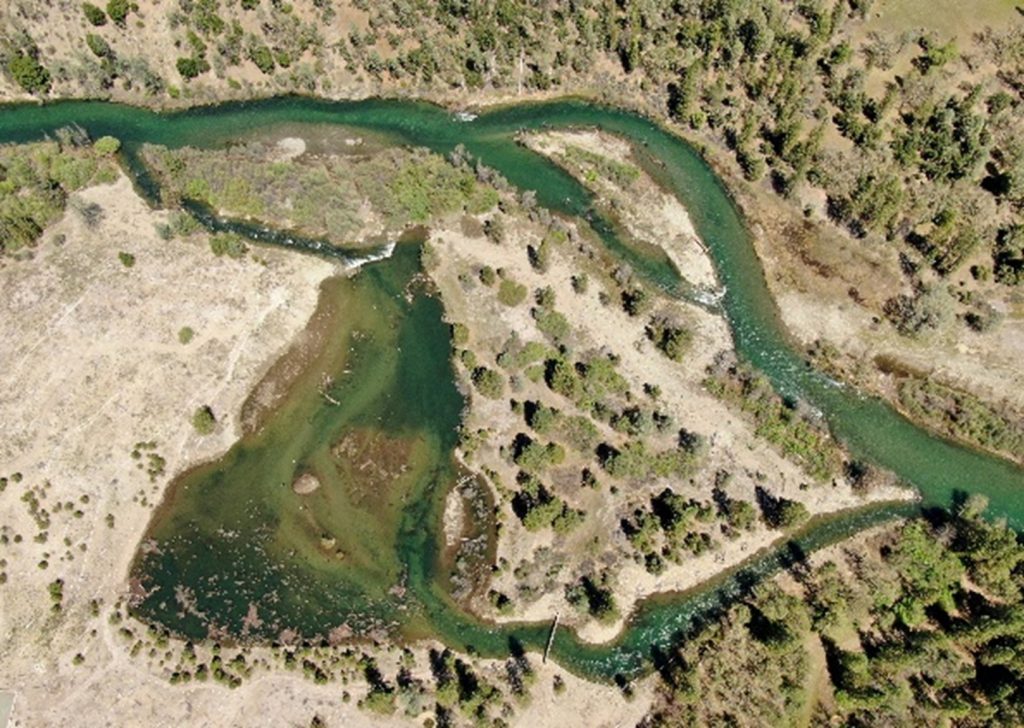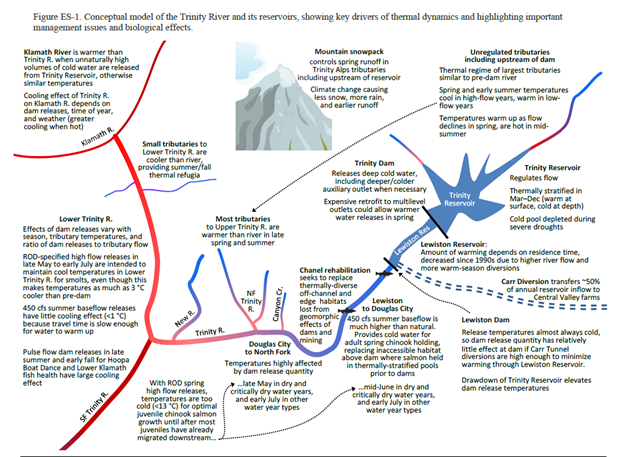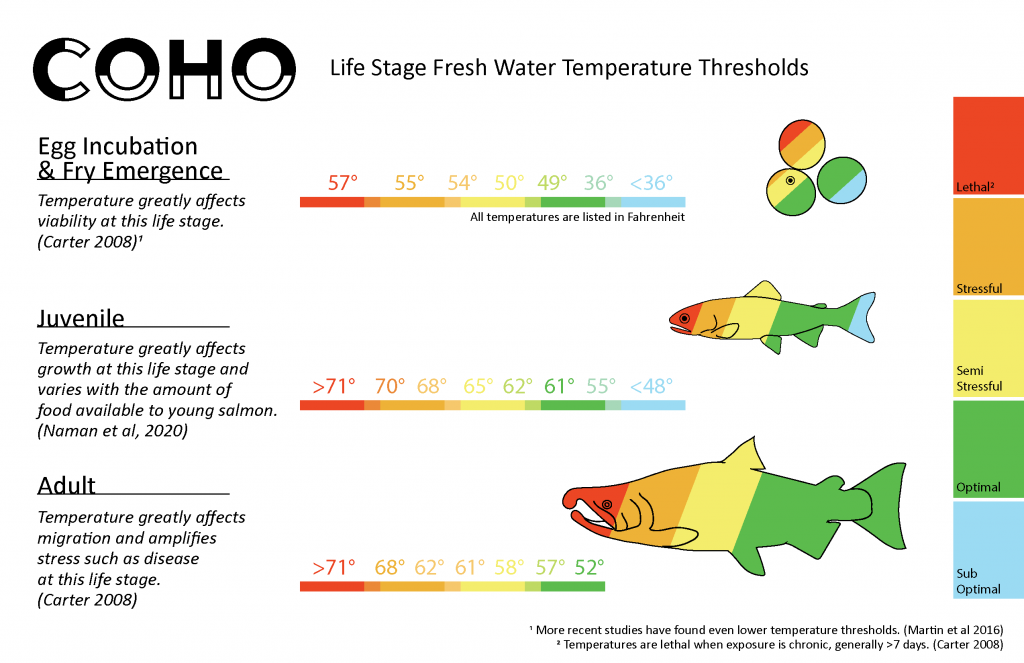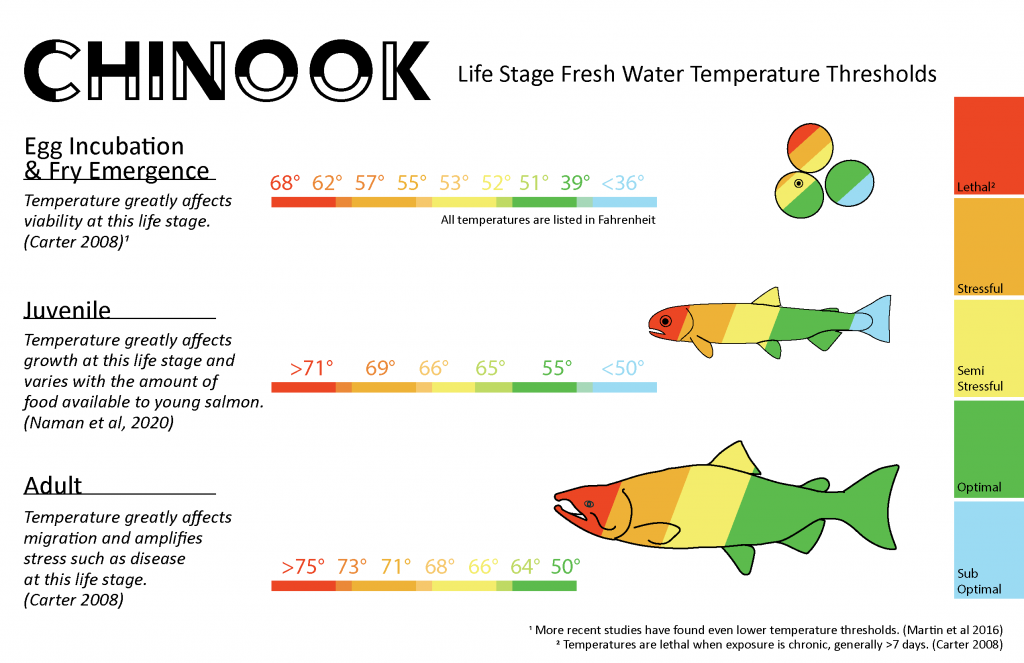
This image shows the Bucktail channel rehabilitation site in April 2019, three years after construction. This image illustrates a pond with a beaver dam analogue in the location of a former gravel quarry that is connected to the river by a perennial side channel (lower right), a main channel that reoccupied a channel that filled in after Trinity Dam was completed (top of photo), and an alcove with perennial flow (second channel from top). The variety of water depths, velocities, and temperatures resulting from the project are intended to provide good rearing conditions for all anadromous fish species that may use the site. Photo by A. Martin, Yurok Tribal Fisheries Dept., 2019.
A Brief Introduction to Thermal Ecology of the Trinity River
Rivers, particularly those in Mediterranean climates, are extremely complicated systems (see figure 1). Water temperatures in unregulated rivers vary over time and space. They tend to be warm in the summer, cold in the winter, colder in the headwaters than in downstream reaches, and colder at the bottom of slowly moving, deep pools. Temperatures in tributaries often differ from mainstem rivers and create even more variability in the system. This complexity ‘muddies the water’ when the topic of water temperatures comes up in conversation or when making flow management decisions. To complicate matters more, dams and diversions strongly affect water temperatures, especially how they change over time and space, so river managers have invested heavily [1] in understanding riverine thermal patterns to better maintain water temperatures needed by fish and wildlife.

It is well known that native Trinity River salmonids – Coho, spring and fall Chinook, and winter and summer steelhead – generally require ‘cold’ water. However, Trinity River ecology is more complex than that, as salmonid temperature needs vary by species and life stage. When speaking in generalities, there are a few truths. Mortality is likely if daily average water temperatures reach 73°F (23°C) for young and mature salmonids alike, however, if adult salmonids can access cooler water and don’t encounter other stressors they can survive. When salmonids are young and food is unlimited, optimal growth in freshwater occurs between 55°F-65°F (12°C-18°C), and seasonal runs of adult Chinook salmon stop migrating upstream when temperatures exceed about 68°F (20°C). Among salmonids, Coho eggs are the most sensitive to temperature while they develop in the gravel during the winter months. Optimal temperatures range from 36°F-44°F (2.5°C-6.5°C). Survival rates begin to decline at temperatures above 50°F (10°C).
When a river is dammed, water pools behind it and is exposed to sunlight and warm air, and the water inevitably warms. Water that is too warm directly kills salmon. Conversely, with cooler water, salmonids also have a threshold as low temperatures slow growth and can enhance conditions for some diseases, and mask environmental cues for migration. Since cooler waters do not directly kill salmonids and since the degradation of cooler temperatures affects out migrating young salmon vs adult salmon, managers have been conserving salmon in dam-regulated rivers as cold as possible. Doing this is straightforward: release water from deep in the lake (where water is colder than at the top), and release as much of this cold water as is necessary to keep the tailwater at the desired temperature downstream to the desired point. However, from empirical data, we know that rivers within a Mediterranean climate warm in the summer. In fact, the seminal fisheries investigation on the Trinity River [2] documented summer surface water temperatures of about 80°F (27°C) in the Lewiston area, and simultaneously salmon were present and thriving in this environment. Anecdotal reports from long-time Trinity County residents also suggest that very low flows, “to the point that one could walk across the river”, in places, without getting wet – were frequent and salmonids were able to handle these conditions just fine. Coincidentally, these warmer, slower flows were also needed by other aquatic species that co-evolved with salmonids such as the foothill yellow-legged frog and western pond turtle whom we have seen decline in dammed rivers due to higher summer flows and colder temperatures.
Fish biologists will tout the natural warming of a river found in Mediterranean-climates as a benefit because warm summer waters stop upstream salmon migration. Thermal barriers separate the spring and fall Chinook runs and minimize interbreeding between the runs. This is important because when individuals from these two runs interbreed, their adult offspring are rewired to begin their upstream migration in the hottest months of the summer [3] and depending on the year these re-wired fish can enter into poor to very poor river conditions.
Managers can achieve a cold river by one of two ways. Using the current system they release lots of water (450cfs) from the deep in the reservoir and keep the river cold. This large mass of cold water gradually and uniformly warms as it goes downstream. The second management system would be to release less cold water to promote stratification, and have both warm and cold water in close proximity to each other for a long ways downstream. For many years, public opinion and legal requirements, informed by our limited understanding of how rivers work, has favored the former strategy. In the future, an ever-shrinking water supply, a better understanding of thermal ecology, and perhaps a need to conserve other species along with salmonids, requires each of us to explore the latter.
- J. Eli Asarian, Kyle De Juilio, David Gaeuman, Seth Naman, and Todd Buxton. (2023). Synthesizing 87 years of scientific inquiry into Trinity River water temperatures. 80 p. + appendices. Prepared for the Trinity River Restoration Program, Weaverville, California.
- Moffett, J. W. and Smith, S. H. (1950) Biological Investigations of the Fishery Resources of Trinity River, California. Special Scientific Report – Fisher No. 12 from the U.S. Fish and Wildlife Service.
- Neil F. Thompson, Eric C. Anderson, Anthony J. Clemento, Matthew A. Campbell, Devon E. Pearse, James W. Hearsey, Andrew P. Kinziger, and John Carlos Garza. (2020). A complex phenotype in salmon controlled by a simple change in migratory timing. Science, 370 (6516)
- Buxton, T. H., Y. G. Lai, N. A. Som, E. Peterson, and B. Abban. 2022. The mechanics of diurnal thermal stratification in river pools: Implications for water management and species conservation. Hydrological Processes 36(11):e14749. DOI: 10.1002/hyp.14749.
- Carter, Katharine (2008). Effects of Temperature, Dissolved Oxygen/Total Dissolved Gas, Ammonia, and pH on Salmonids – Implecations for California’s North Coast TMDLs.


